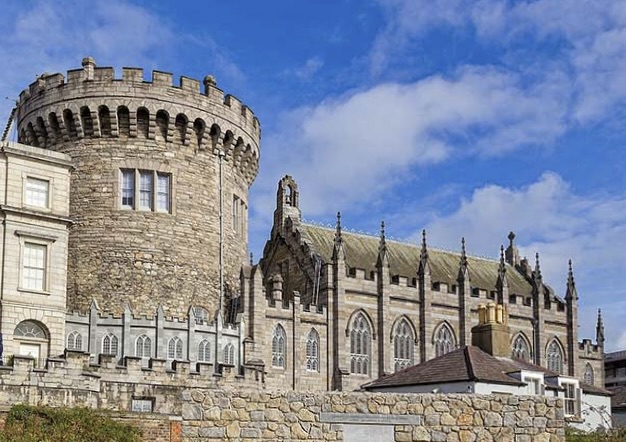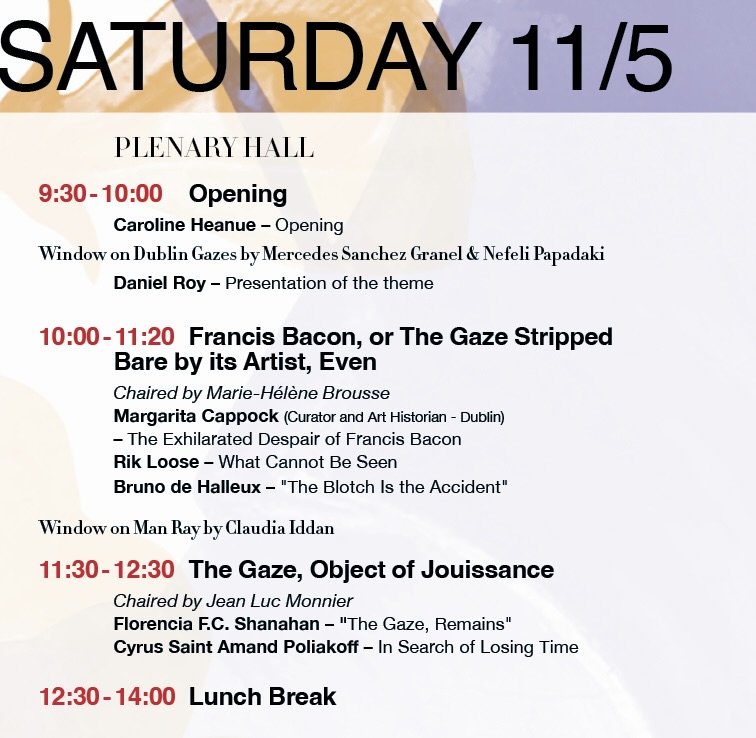
The New Lacanian School (NLS)
International Congress 2024
CLINIC OF THE GAZE
“Today, the object of our gaze is in our pocket, in the form of the mobile phone, the smartphone. For the new generations, it’s simpler: it’s in the hand, inseparable from the body, which can say quite rightly: io sono sempre visto! (I am always seen!)”
This Congress was held on 11-12 May 2024 at Dublin Castle, Ireland
The Congress blog is here
The NLS website is here

Clinic of the restitution of the gaze to the field of the Other
Clinic of the return of the object gaze onto the body
Clinic of the return of the object gaze in the real
Clinic of the gaze in the fantasm
Saturday 11 May (Paris times)
9:30am – 10:00am: OPENING by Caroline Heanue, Chair of ICLO, and INTRODUCTION by Daniel Roy, President of the NLS
10:00am – 11:20am: Francis Bacon or The Gaze Laid Bare by its Artist, Even
11:30am – 12:30pm: The Gaze, Object of Jouissance
2:00pm – 5:00pm: PARALLEL SESSIONS, Streaming of one room (6 Clinical Presentations)


Sunday 12 May (Paris times)
9:30am – 10:55am: CLINICAL CONVERSATION, Two clinical cases presented and discussed
11:00am – 12:15pm: Seduction, Modesty and Masquerade: The Gaze in the Feminine
1:15pm – 2:15pm: Dream Scene – Fantasy Screen
2:15pm – 3:00pm: The Pass in the School One
3:00pm – 3:20pm: Congress 2025 presentation, Patricia Bosquin Caroz
3:20pm – 3:30pm: Concluding remarks and thanks

Presentation of the Theme
By NLS President
Daniel Roy
The clinic of the gaze has a very humble origin in our field. With a few exceptions, which will have to be accounted for, there is nothing spectacular about it. It is concomitant with the entry into analysis at the moment at which, passing to the couch, having become analysand, the patient can no longer draw support from the analyst’s gaze, the moment at which the latter is situated outside the analysand’s field of vision.
A cut – A desire
It is at this moment that the gaze emerges as a separated object, separated from the exchange of the specular relation. In this way, the gaze object was born of Freud’s desire, at the moment at which he invented the analytic device. For each analysis, the analyst’s desire intervenes to create this field where the gaze can isolate itself as a separate object. This is how the object gaze results from a subtraction, or, more radically, a cut. We might ask whether this double condition – a desire embodied in act and the irreversible modality of the cut – which, in our field, isolates the gaze as an object, can be found in other fields as well: in the aesthetic theories of philosophers and art historians, in artistic practice, in practices of love, and so on.
Abject stain and blinding brilliance
As far as our own field is concerned, we verify this manifestation of the gaze as object in the treatment each time the analysand sees himself as a blot in the picture, and often not a very clear blot, or conversely when he begins to shine as bright as a beacon with a speech that sparkles in order to dazzle, or even blind, the supposed gaze of the analyst. This movement is very present in treatment with children, in which drawings, games and pantomimes are summoned from the field of the visible to fill the gap perceived in the Other, just as the child is at the task of confronting it. But anecdotes, colourful narratives, sophisticated plots, all carried by the voice in the session of so called adult subjects have no less a function than to arouse the curiosity of the Other and saturate his attention, both offspring of the drive according to Freud: the scopic drive for curiosity, 1 the drive to know for attention. 2
Four clinical perspectives
The return effect of the object gaze on the speaking body opens up four clinical perspectives for our study. In the transference, an entire clinic of the restitution of the gaze to the field of the Other, which aims to counteract the effect of the cut, is inaugurated here. 3 This clinic of the Other’s gaze – of which Lacan says that “we must conceptualise the Other’s gaze as being internalised by a sign […]. Ein einziger Zug”4 – is the clinic of the ego ideal, I(A), where the subject can see himself as lovable or hateful, acceptable or unacceptable. This clinic is that of neurosis, if we do not forget that it is accompanied by a clinic of the gaze in the fantasm, 5 where it is fixed as an object of jouissance that is subtracted from or added to the Other: Lacan refers to these two features of perversion as voyeurism and exhibitionism. 6
This knotting together of jouissance and the Other that the object gaze brings about is grasped by Lacan in a very explicit way in “Television” with reference to Dante and Beatrice: “A gaze, that of Beatrice – that is to say, three times nothing, a fluttering of the eyelids and the exquisite trash that results from it – and there emerges that Other whom we can identify only through her jouissance: her whom he, Dante, cannot satisfy, because from her, he can have only this look, only this object, but of whom he tells us that god fulfils her utterly…” 7
We will also have to explore a clinic of the return of the object gaze onto the body, the gaze as the lining of the specular image, which either makes it hold together or, on the contrary, depersonalises it, marks it, even tears it apart. Another clinical question arises here: where do we situate the gaze, and its function, in the writing of psychosomatic phenomenon, better named by Lacan as an “epistemo-somatic flaw”?
There is also a clinic of the return of the object gaze in the real, where it emerges as really detached from the body: the “fugitive gaze” of the delusion of being watched, watching out for the subject at the corner of every street, at every encounter – Freud’s “A Case of Paranoia Running Counter to the Psychoanalytic Theory of the Disease” 8 being paradigmatic of this – or a universe that has become entirely gaze, from which the subject can no longer escape – we recall here a drawing of a schizophrenic patient presented by Pr Bobon, and evoked by Lacan in his Seminar on Anxiety, 9 a tree whose trunk is covered with a vertical series of gazing eyes, “garlanded by drawn symbols that formed one correct phrase, the first for years, the key phrase of her delusion – Io sono sempre vista – “I’m always in view”. 10
The gaze as a pleasurable substance added to the world
It is remarkable that these last two movements – the return of the gaze onto the body and the return of the gaze in the real – are now being imposed on a massive scale outside of analytic treatment. They are the vectors in the social body of the function of the gaze as a pure enjoying substance detached from living bodies and affecting them in return.
The appearance of the cinematograph and the kinetoscope – both on the old European continent and in the New World in the United States at the same time, shortly preceded the emergence of the scopic drive in Freud’s writings, which, along with the drive of cruelty, “already observed in childhood as independent impulses, distinct in the first instance from erotogenic sexual activity”. 11 The perversions of voyeurism and exhibitionism date from this period: like cinemascope, they take up this “autonomous tendency” of the gaze for their enjoyment, through a complex device that summons other bodies to produce the gaze.
Similarly, the emergence of the gaze as objet a in Lacan’s teaching comes at the time of television, a device that makes the image projected onto a screen disappear in favour of an image that emerges from the screen to present the viewer with everything that is regarding him [qui le regarde] and not to show what doesn’t regard him [qui ne le regard pas]… In Seminar XI, 12 Lacan extracts the gaze from this trap, which is far more formidable than the painter’s picture, which cannot exist without the artist’s desire. Indeed, this trap is no longer that of the pervert’s jouissance, but that of surplus jouissance placed at the service of the “master of tomorrow”, the one who says and shows what is appropriate to be seen and heard today.
Today, the object of our gaze is in our pocket, in the form of the mobile phone, the smartphone – in the pocket or in the bag, because there is still a certain gender difference, at least among the boomers. For the new generations, it’s simpler: it’s in the hand, inseparable from the body, which can say quite rightly: io sono sempre visto! (I am always seen!).
Today, psychoanalysts and practitioners are confronted with a new clinic of the gaze, a clinic of the real gaze, without screen, unseparated [inséparé] from the imaginary body; this conjunction renders the Other of the signifier precarious, or confused, or disordered, or more radically foreign and persecuting when the unseparated reveals itself to be inseparable. This is the clinic of the adolescents of this century, and we have to learn the logic of it with them, building on the few grains of sand that make up the unary traits that are a sign to them, one by one, and which thus distinguish them and on the basis of which they can distinguish themselves. It’s up to us to distinguish these “unary traits” in their own language, so that we can add our own spice to it.
Translated by Philip Dravers
1 Freud S. Three Essays on Sexuality, SEVII p. 192.
2 Ibid. p. 194 and 204.
3 Miller J.-A., « D’un regard, l’étrangeté », La Cause du désir n°102, Navarin éditeur, Paris, 2019, p. 4555.
4 Lacan J., Transference: The Seminar, Book VII, Cambridge, Polity, 2015, p. 355-6.
5 [T.N. Translation specified by the author.]
6 Lacan J., From an Other to the other, Cambridge, Polity, 2023, chapter 16 (forthcoming, September 2023).
7 Lacan J., “Television”, Television: A Challenge to the Psychoanalytic Establishment, London and New York, Norton, 1990. p. 23.
8 Freud S., S.E. 1915, 14: 261-272.
9 Lacan J., Anxiety, The Seminar, Book X, Cambridge, Polity, 2004, p. 73-4.
10 Bobon J. « Leçon inaugurale (extraits) », Ornicar ? Revue du Champ freudien, n° 29, avril-juin 1984, Navarin éditeur, p. 162-165.
11 Freud S. op. cit. p. 192.
12 Lacan J., The Four Fundamental Concepts of Psychoanalysis, text established by Jacques-Alain Miller, London, Penguin, 1977, chap. vi to ix, pp. 65-119. (Of the Gaze as objet petit a).
Visit the NLS International Congress 2023 here
Visit our NLS information page here
Visit the WAP 2024 Congress here
Return to our home page here
